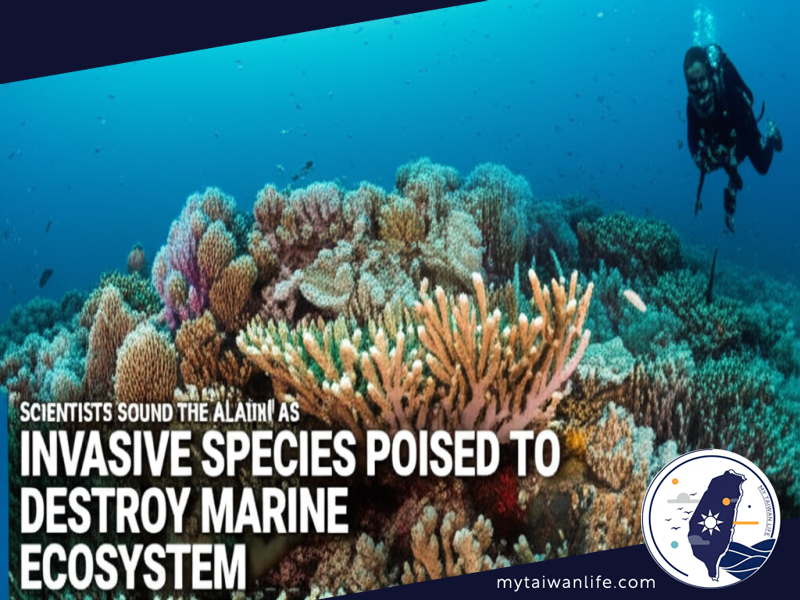Urgent Alert: Coral-Eating Starfish Threaten to Devastate Taiwan's Pratas Islands in Two Years
Scientists Sound the Alarm as Invasive Species Poised to Destroy Marine Ecosystem, Highlighting Need for Immediate Action

Taipei, May 8 – A dire warning has been issued regarding the fate of Taiwan's pristine Pratas Islands National Park, the nation's only marine national park. According to a leading scholar, the coral reefs surrounding the islands face potential devastation within the next two years due to an escalating infestation of coral-eating starfish.
At a press conference in Taipei, Jeng Ming-shiou (鄭明修), executive officer of the Biodiversity Research Center at Academia Sinica, pinpointed the crown-of-thorns starfish (COTS), scientifically known as Acanthaster planci, as the primary culprit behind the rapid decline of hard coral in the region.
The Taiwanese Coral Reef Society has stated that COTS, a heavily spined starfish, poses a grave threat, having previously decimated coral ecosystems in locations such as Australia and Guam, among others worldwide.
Jeng's two-year projection is based on the observed impact of a 1967 COTS outbreak in Guam, where the starfish obliterated all coral within a 38-kilometer radius in just 2.5 years.
Jeng highlighted that a similar pattern is emerging around the Pratas Islands, with the COTS invasion having commenced in 2019. He noted a doubling in the average size of the starfish, from 15-20 cm to approximately 40 cm, with some reaching up to 60 cm.
The starfish are spreading at a rate of about 1 kilometer per month along the outer ring of the islands. If their proliferation remains unchecked, they could consume all coral along the islands' 47-km perimeter within the next two years, Jeng cautioned.
Referencing recent data from his volunteer team, Jeng reported the removal of 33,748 COTS from a 1.6-hectare area on the park's southern side during March and April 2025. This exceeded the team's initial projection of 29,200.
He also pointed out that many starfish likely remain hidden in waters deeper than 30 meters, making them difficult to locate for non-professional divers.
Jeng, who has been conducting underwater surveys for five decades, expressed concern that the current infestation has overwhelmed civil groups and national park staff. He noted that volunteers are experiencing physical strain and injuries after participating in eight-day COTS-hunting missions.
A single adult COTS, measuring 40 cm, can produce approximately 300 million eggs annually, predominantly during June and July, Jeng said.
While the Taiwanese Coral Reef Society enlisted 141 volunteers in 2024, coral-clearing operations are limited to about 100 days per year due to weather conditions, including typhoons and ocean currents.
Jeng proposed that a cross-division task force formed by the government could significantly aid in addressing the situation.
Emphasizing the critical role of coral reefs in sheltering juvenile fish and shrimp, as well as supporting numerous seafood species, Jeng described them as the "rainforest of the ocean." He likened the ongoing destruction at the Pratas Islands to a "conflagration" demanding immediate attention.
"If you are interested in the marine ecosystem, please join us," he urged. "The next two months are crucial."
Other Versions
Alerta urgente: las estrellas de mar devoradoras de coral amenazan con devastar las islas Pratas de Taiwán en dos años
Alerte urgente : des étoiles de mer dévoreuses de coraux menacent de dévaster les îles Pratas de Taïwan dans deux ans
Peringatan Mendesak: Bintang Laut Pemakan Karang Mengancam Menghancurkan Kepulauan Pratas Taiwan dalam Dua Tahun
Allarme urgente: le stelle marine mangiatrici di corallo rischiano di devastare le isole Pratas di Taiwan nel giro di due anni
緊急警告:サンゴを食べるオニヒトデが台湾のプラタス諸島を2年以内に破壊するおそれ
긴급 경보: 산호를 먹는 불가사리가 2년 안에 대만의 프라타스 섬을 황폐화시킬 위협이 있습니다.
Agad na Babala: Mga Starfish na Kumakain ng Korales Nagbabanta na Sumira sa Isla ng Pratas ng Taiwan sa Loob ng Dalawang Taon
Срочная тревога: коралловая морская звезда угрожает опустошить острова Пратас на Тайване в течение двух лет
แจ้งเตือนด่วน: ปลาดาวกินปะการังคุกคามทำลายหมู่เกาะปราตัสของไต้หวันภายในสองปี
Cảnh báo khẩn cấp: Sao biển ăn san hô đe dọa tàn phá quần đảo Pratas của Đài Loan trong hai năm
Categories
Warning: Undefined array key "article_category" in /web/htdocs/www.mytaiwanlife.com/home/news/sidebar.php on line 126
Deprecated: html_entity_decode(): Passing null to parameter #1 ($string) of type string is deprecated in /web/htdocs/www.mytaiwanlife.com/home/news/sidebar.php on line 126
Warning: Undefined array key "article_category" in /web/htdocs/www.mytaiwanlife.com/home/news/sidebar.php on line 126
Deprecated: html_entity_decode(): Passing null to parameter #1 ($string) of type string is deprecated in /web/htdocs/www.mytaiwanlife.com/home/news/sidebar.php on line 126
Warning: Undefined array key "article_category" in /web/htdocs/www.mytaiwanlife.com/home/news/sidebar.php on line 126
Deprecated: html_entity_decode(): Passing null to parameter #1 ($string) of type string is deprecated in /web/htdocs/www.mytaiwanlife.com/home/news/sidebar.php on line 126
Warning: Undefined array key "article_category" in /web/htdocs/www.mytaiwanlife.com/home/news/sidebar.php on line 126
Deprecated: html_entity_decode(): Passing null to parameter #1 ($string) of type string is deprecated in /web/htdocs/www.mytaiwanlife.com/home/news/sidebar.php on line 126
Warning: Undefined array key "article_category" in /web/htdocs/www.mytaiwanlife.com/home/news/sidebar.php on line 126
Deprecated: html_entity_decode(): Passing null to parameter #1 ($string) of type string is deprecated in /web/htdocs/www.mytaiwanlife.com/home/news/sidebar.php on line 126
Warning: Undefined array key "article_category" in /web/htdocs/www.mytaiwanlife.com/home/news/sidebar.php on line 126
Deprecated: html_entity_decode(): Passing null to parameter #1 ($string) of type string is deprecated in /web/htdocs/www.mytaiwanlife.com/home/news/sidebar.php on line 126

